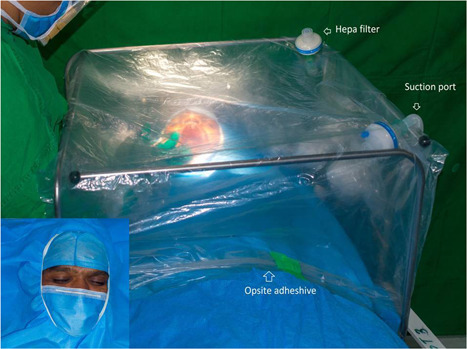The spread of coronavirus disease 2019 (COVID‐19) has rattled people worldwide. The risk of infection to healthcare workers has become the prime concern, especially, in areas where community spread is ongoing. The severe acute respiratory syndrome coronavirus (SARS‐CoV) is a novel virus for which no definitive treatment is available in the form of vaccine or any antiviral drug till date. 1 Many procedures are being deferred at the time of this pandemic, but the management of cancer patients does not come under the realm of elective procedures. India has the highest incidence of oral cavity cancer, around 10.4% of all cancers, with a projected number of 119 992 cases in 2018. 2 Oral cavity examination, performing biopsies from oral cavity lesions and performing flexible optical bronchoscopy (FOB) has a high risk of exposure to saliva, nasal secretions, and aerosols (especially while coughing).
Asymptomatic carriers can also spread the COVID‐19. 3 , 4 Despite all screening measures, a risk of infection is always there. Due to the limited availability of outpatient department (OPD) spaces and biopsy stations, multiple biopsies have to be done in the same examination/biopsy/minor procedural room in quick succession. Standard personal protective equipment (PPE) used by the cancer caregiver cuts down the risk of aerosol spread while taking biopsies. However, a common examination/biopsy room with high patient turnover subjects subsequent patients to aerosol exposure. Aerosol boxes are being marketed and even theorized to reduce aerosol exposure while intubation, 5 which are not readily available. They are also not disposable and need cleaning and sterilization after every use. Even though they offer protection to the healthcare workers during the procedure, but they do not prevent aerosol spread in the room.
We have made a disposable customized aerosol containment chamber (DCAC chamber), which can be fabricated quickly with material readily available in any hospital with an inbuilt suction mechanism for the evacuation of aerosol produced while taking a biopsy or doing fiber optic bronchoscopy.
The material required for making this disposable aerosol chamber is available in most operation theaters. It is made in the form of a transparent plastic cube that rests over four‐screen stands fixed around the operating table. It has ports on two sides through which operating surgeon and assistant (if required) can introduce their hands and instruments to take biopsies. There is one hepa filter for air entry and one port for suction. The suction chamber has hypochlorite solution for disinfection.
Once the patient lies down on the operating table, a disposable drape sheet of spunbond meltblown spunbond (SMS) fabric is placed over him. The drape has an aperture with an elastic band around it to snugly fit around the face. The DCAC chamber is then mounted over the screen stands. Its edges are secured to the SMS drape with Opsite adhesive sheet (Figure 1). This makes it airtight to avoid aerosol escape. The procedure is completed and the aerosol box can be disposed of after the procedure is complete. The working hand ports are made using laparoscopy camera cover, secured to the sides of the chamber. There is an elastic band that seals around the wrist and prevents any aerosol leak from hand ports. The biopsy container already kept inside is closed and extracted from an assistant port leaving the part of glove in situ to contain aerosol exposure.
Figure 1.

Fully mounted DCAC chamber with snugly fitting SMS fabric sheet in inset. DCAC, disposable customized aerosol containment; SMS, spunbond meltblown spunbond [Color figure can be viewed at wileyonlinelibrary.com]
Maneuverability, as compared to other rigid chambers is also easy. 5 The operating surgeon has more freedom of movement. There is negligible aerosol spread due to closed enclosure. The healthy subject in demonstration video had no suffocation or discomfort during the mounting and unmounting of the whole apparatus. There is no contact between the aerosolized interior of the chamber with the outside environment throughout the procedure. The chamber can be safely disposed of. The next procedure can be done after following the routine cleaning protocol.
Relative contraindications: claustrophobic patients may find it inconvenient.
CONFLICT OF INTERESTS
The authors declare that there are no conflict of interests.
ACKNOWLEDGEMENTS
Operating room staff including sisters and operation theater attendants.
Sharma SS, Singh DK, Yadav AK, et al. Disposable customized aerosol containment chamber for oral cancer biopsy: A novel technique during COVID‐19 pandemic. J Surg Oncol. 2020;122:120–121. 10.1002/jso.25962
DATA AVAILABILITY STATEMENT
There are no shared data used in the manuscript.
REFERENCES
- 1. Cunningham AC, Goh HP, Koh D. Treatment of COVID‐19: old tricks for new challenges. [published online ahead of print Mar 16, 2020]. Crit Care. 2020;24:91. 10.1186/s13054-020-2818-6 [DOI] [PMC free article] [PubMed] [Google Scholar]
- 2. Dar M, Sharma K. Burden of cancer in India: GLOBOCAN 2018 estimates incidence, mortality, prevalence and future projections of cancer in India. J Emerg Technol Innovat Res. 2018;6(6):e505. [Google Scholar]
- 3. Bai Y, Yao L, Wei T, et al. Presumed asymptomatic carrier transmission of COVID‐19. [published online ahead of print Feb 21, 2020]. JAMA. 2020;323(14):1406‐1407. 10.1001/jama.2020.2565 [DOI] [PMC free article] [PubMed] [Google Scholar]
- 4. Ye F, Xu S, Rong Z, et al. Delivery of infection from asymptomatic carriers of COVID‐19 in a familial cluster. [published online ahead of print Apr 02, 2020]. Int J Infect Dis. 2020. 10.1016/j.ijid2020.03.042 [DOI] [PMC free article] [PubMed] [Google Scholar]
- 5. Canelli R, Connor CW, Gonzalez M, Nozari A, Ortega R. Barrier enclosure during endotracheal intubation. [published online ahead of print Apr 3, 2020]. N Engl J Med. 2020. 10.1056/NEJMc2007589 [DOI] [PMC free article] [PubMed] [Google Scholar]
Associated Data
This section collects any data citations, data availability statements, or supplementary materials included in this article.
Data Availability Statement
There are no shared data used in the manuscript.


